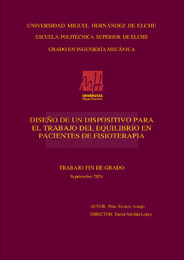Título :
Diseño de un dispositivo para el trabajo del equilibrio en pacientes de fisioterapia |
Autor :
Álvarez Araujo, Pilar Lucía |
Tutor:
Abellan Lopez, David  |
Editor :
Universidad Miguel Hernández de Elche |
Departamento:
Departamentos de la UMH::Ingeniería Mecánica y Energía |
Fecha de publicación:
2024-09 |
URI :
https://hdl.handle.net/11000/34046 |
Resumen :
Introducción. El equilibrio es una capacidad fundamental para el control del movimiento
y la posición del cuerpo, por lo que es frecuente encontrar alteraciones de este tanto de
manera primaria como secundaria, así como de manera fisiológica. La presencia de
dispositivos que permitan el trabajo de esta capacidad es bastante limitada en el mercado,
además de las numerosas limitaciones que presentan.
Objetivos. Detectar las necesidades de los profesionales en clínicas en cuanto al
desarrollo y tratamiento de las capacidades de equilibrio en distintos pacientes. Diseñar
un dispositivo que cumpla dichas necesidades en colaboración con Fisioterapia.
Metodología. 1) Establecimiento de requisitos que debe cumplir la máquina. 2) Propuesta
de mecanismos que cumplan con los requisitos establecidos por el ámbito de Fisioterapia.
3) Análisis de ventajas e inconvenientes de cada una de las propuestas y selección. 4)
Diseño en detalle del prototipo; selección de componentes, diseño en 3D y cálculos. 5)
Elaboración de la documentación; planos, memoria y anexos.
Resultados. Las principales necesidades en cuanto al diseño de la máquina es que fuera
versátil y universal, que se pueda emplear en un amplio rango de individuos, y que a su
vez sea de fácil uso por el personal fisioterapeuta. Además, ha de presentar un precio
asequible y una fácil forma de fabricación.
Conclusión. Este trabajo aporta un avance en cuanto a las necesidades del personal de
Fisioterapia y las posibles soluciones para el diseño de un dispositivo nuevo para el
trabajo del equilibrio en clínica.
Introduction. Balance is a fundamental capacity for the control of movement and body
position, which is why it is common to find alterations in it, both primary and secondary,
as well as physiological. The presence of devices that allow the work of this ability is
quite limited in the market, in addition to the numerous limitations they present.
Objectives. To detect the needs of professionals in clinics in terms of the development
and treatment of balance skills in different patients. To design a device that meets these
needs in collaboration with Physiotherapy.
Methodology. 1) Establishment of the requirements for the machine to accomplish 2)
Proposal of mechanisms that meet the requirements established by the field of
Physiotherapy. 3) Analisys of advantages and disadvantages of each of the proposals and
selection. 4) Detailed design of the prototype of the machine; selection of components,
3D design and calculation9s. 5) Preparation of the documentation; plans, report and
annexes.
Results. The main requirements for the design of the machine are that it should be
versatile and universal, that it can be used by a wide range of individuals, and that it
should be easy to use by physiotherapists. In addition, it should be affordable and easy to
manufacture.
Conclusion. This work provides an advance in terms of the needs of physiotherapy staff
and possible solutions for the design of a new device for balance work in the clinic.
|
Palabras clave/Materias:
equilibrio
tratamiento
dispositivo
diseño mecánico
prototipo
balance
treatment
device
mechanical design
prototype |
Área de conocimiento :
CDU: Ciencias aplicadas: Ingeniería. Tecnología |
Tipo de documento :
info:eu-repo/semantics/bachelorThesis |
Derechos de acceso:
info:eu-repo/semantics/openAccess |
Aparece en las colecciones:
TFG-Ingeniería Mecánica
|
 La licencia se describe como: Atribución-NonComercial-NoDerivada 4.0 Internacional.
La licencia se describe como: Atribución-NonComercial-NoDerivada 4.0 Internacional.
.png)
